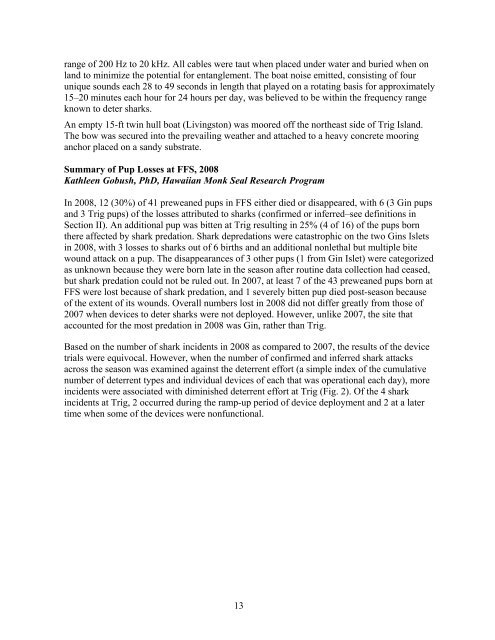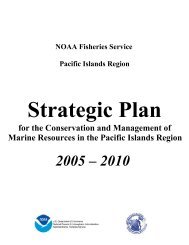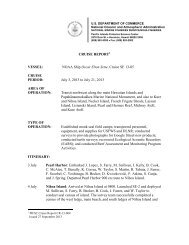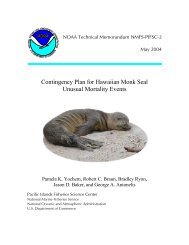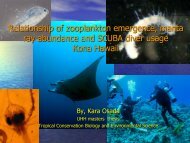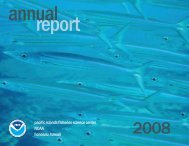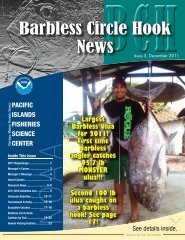Shark Predation on Hawaiian Monk Seals - Pacific Islands Fisheries ...
Shark Predation on Hawaiian Monk Seals - Pacific Islands Fisheries ...
Shark Predation on Hawaiian Monk Seals - Pacific Islands Fisheries ...
You also want an ePaper? Increase the reach of your titles
YUMPU automatically turns print PDFs into web optimized ePapers that Google loves.
ange of 200 Hz to 20 kHz. All cables were taut when placed under water and buried when <strong>on</strong><br />
land to minimize the potential for entanglement. The boat noise emitted, c<strong>on</strong>sisting of four<br />
unique sounds each 28 to 49 sec<strong>on</strong>ds in length that played <strong>on</strong> a rotating basis for approximately<br />
15–20 minutes each hour for 24 hours per day, was believed to be within the frequency range<br />
known to deter sharks.<br />
An empty 15-ft twin hull boat (Livingst<strong>on</strong>) was moored off the northeast side of Trig Island.<br />
The bow was secured into the prevailing weather and attached to a heavy c<strong>on</strong>crete mooring<br />
anchor placed <strong>on</strong> a sandy substrate.<br />
Summary of Pup Losses at FFS, 2008<br />
Kathleen Gobush, PhD, <strong>Hawaiian</strong> M<strong>on</strong>k Seal Research Program<br />
In 2008, 12 (30%) of 41 preweaned pups in FFS either died or disappeared, with 6 (3 Gin pups<br />
and 3 Trig pups) of the losses attributed to sharks (c<strong>on</strong>firmed or inferred–see definiti<strong>on</strong>s in<br />
Secti<strong>on</strong> II). An additi<strong>on</strong>al pup was bitten at Trig resulting in 25% (4 of 16) of the pups born<br />
there affected by shark predati<strong>on</strong>. <str<strong>on</strong>g>Shark</str<strong>on</strong>g> depredati<strong>on</strong>s were catastrophic <strong>on</strong> the two Gins Islets<br />
in 2008, with 3 losses to sharks out of 6 births and an additi<strong>on</strong>al n<strong>on</strong>lethal but multiple bite<br />
wound attack <strong>on</strong> a pup. The disappearances of 3 other pups (1 from Gin Islet) were categorized<br />
as unknown because they were born late in the seas<strong>on</strong> after routine data collecti<strong>on</strong> had ceased,<br />
but shark predati<strong>on</strong> could not be ruled out. In 2007, at least 7 of the 43 preweaned pups born at<br />
FFS were lost because of shark predati<strong>on</strong>, and 1 severely bitten pup died post-seas<strong>on</strong> because<br />
of the extent of its wounds. Overall numbers lost in 2008 did not differ greatly from those of<br />
2007 when devices to deter sharks were not deployed. However, unlike 2007, the site that<br />
accounted for the most predati<strong>on</strong> in 2008 was Gin, rather than Trig.<br />
Based <strong>on</strong> the number of shark incidents in 2008 as compared to 2007, the results of the device<br />
trials were equivocal. However, when the number of c<strong>on</strong>firmed and inferred shark attacks<br />
across the seas<strong>on</strong> was examined against the deterrent effort (a simple index of the cumulative<br />
number of deterrent types and individual devices of each that was operati<strong>on</strong>al each day), more<br />
incidents were associated with diminished deterrent effort at Trig (Fig. 2). Of the 4 shark<br />
incidents at Trig, 2 occurred during the ramp-up period of device deployment and 2 at a later<br />
time when some of the devices were n<strong>on</strong>functi<strong>on</strong>al.<br />
13


